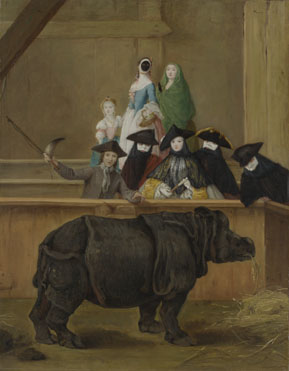Born on this day in 1701 was the great Venetian painter of charming (and strangely haunting) genre scenes, Pietro Longhi. His Exhibition of a Rhinoceros in Venice (above) is one of the minor delights of the National Gallery (and there's another version of it in Venice, in Ca' Rezzonico).
The rhinoceros is Clara, an Indian rhino, who was adopted as an orphan by a Dutch East India Company merchant and shipped to the Netherlands, where she disembarked at Rotterdam and began a hugely successful career as a touring attraction, appearing all over the Continent in the course of the next 17 years. Somewhere along the way, she rubbed off her horn - or it might have been cut off; opinions differ. Note the fellow at the left of Longhi's painting, waving the horn around, no doubt with ribald intent...
Clara eventually ended up at the Horse and Groom public house in Lambeth, where she was exhibited to the curious for a charge of 6d or 1s, and where she died in 1758, aged around 20. For a rhinoceros, she'd had quite a life - and been immortalised in art.
Subscribe to:
Post Comments (Atom)


Interesting, Nige and, judging by it's reasonable accuracy, Longhi must have seen the animal. Unlike Albrecht Durer, who made his rhinoceros woodcut from a description and a fag packet sketch, the poor beast seems to have the feet of a dodo and a smile on it's face. Durer, surprisingly, considering his output, couldn't really do horses either, the apocalypse foursome have strange bendy legs.
ReplyDeleteYes, odd that - even great artists can have weak points, e.g. Turner and the human figure...
ReplyDeleteI was going to add one more nugget of information - the lady in the back row has not been blacked out by a printing fault. She's wearing a kind of Venetian mask known as the Moretta or Servetta Muta. This was held in place by the wearer biting on a button or bit, meaning she couldn't speak while wearing it. Not surprisingly it fell out of fashion soon after the Rhino was painted.